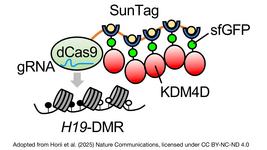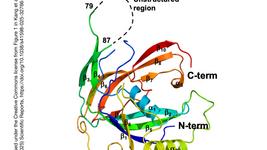CMN Weekly (22 August 2025) - Your Weekly CRISPR Medicine News
By: Gorm Palmgren - Aug. 22, 2025
Top picks
- German and American scientists have used in vivo CRISPR base editing for the correction of pathogenic PKD1 variants - responsible for autosomal dominant polycystic kidney disease (ADPKD). Correction was achieved both in vitro and in a Pkd1 knock-in mouse model of ADPKD, which is the most prevalent genetic kidney disorder, affecting over 10 million individuals worldwide. Editing restored polycystin-1 expression, reduced ER stress, and significantly decreased liver cyst burden. These findings provide the first in vivo evidence that precise genome editing can ameliorate ADPKD features, highlighting therapeutic potential for patients carrying PKD1 mutations.
- Primary human 3D gastric organoids have been used for large-scale CRISPR screening – including knockout, interference, activation and single-cell screens – revealing genetic modulators of cisplatin sensitivity. Coupled with single-cell transcriptomics, the platform uncovered an unanticipated link between fucosylation and drug response and identified TAF6L as key for recovery from cisplatin toxicity. This work underscores 3D organoids as physiologically relevant models for mapping gene-drug interactions in gastric cancer.
Research
- CRISPR-Cas9 knockout of FOXP3 in CD19 CAR T-cell products enhanced cytokine release and sustained cytotoxicity under repeated antigen challenge, without worsening exhaustion. FOXP3, upregulated after CAR stimulation, thus acts as a context-dependent regulator of therapeutic T-cell function. Targeting FOXP3 may bolster CAR T-cell resilience and potency, offering a complementary strategy for cancer and autoimmune therapy optimisation.
- CRISPR-Cas engineering repurposes IscB into an ultracompact RNA-guided RNA editor (R-IscB) by deleting its target-adjacent motif domain to disable dsDNA binding, avoiding Cas13-like collateral toxicity. R-IscB modulates splicing and enables trans-splicing correction in human cells; an ADAR2 fusion drives efficient mRNA A→I editing, while HNH engineering supports cleavage-based knockdown. The strategy extends to convert selected Cas9s into RNA-targeting enzymes.
- Scientists in the Netherlands have screened CRISPR-Cas activity in vitro using on-chip droplet microfluidics and cell-free transcription–translation, establishing a TRL-3 platform for high-throughput selection. Double-emulsion droplets encapsulated TXTL and plasmids, a genetic circuit linked cleavage to fluorescence, and FACS enriched expected gRNA genotypes while bead-based amplification preserved genotype–phenotype linkage.
- A plasmid-delivered prime editing strategy has corrected the glucose-6-phosphate dehydrogenase (G6PD) Viangchan (c.871G>A) mutation in engineered HEK293T cells and a patient-derived iPSC line. Editing reached about 25% in HEK293T and ~5% in sorted iPSCs, with by-products near baseline and no detectable mutations at predicted off-target sites.
- CRISPR-dCas9-TET1 and -DNMT3A editing of the IL1RN promoter in human myeloid cells demonstrated that DNA methylation directly controls IL1RN expression. Altering promoter methylation was sufficient to reprogramme cell fate and modify responses to inflammatory and pathogenic stimuli. This establishes a causal role for locus-specific methylation in immune regulation and highlights targeted epigenome editing as a strategy to modulate inflammation-related diseases.
Screening
- CRISPR-Cas in vivo screens in a melanoma model identified STUB1 as a suppressor of CD8+ T cell antitumour activity. STUB1, together with CHIC2, downregulated cytokine receptors including IL-27Rα and IFNγR1, limiting T cell expansion and function. Stub1 deletion enhanced T cell tumour infiltration, effector responses and tumour control. Targeting STUB1 could thus simultaneously bolster CD8+ T cell immunity and increase tumour vulnerability to killing.
- A genome-wide CRISPR-Cas knockout screen in Eµ-Myc;Cas9 haematopoietic stem/progenitor cells in vivo identified GATOR1 components NPRL3, DEPDC5 and NPRL2 as tumour suppressors. Loss of GATOR1 accelerated MYC-driven lymphomagenesis, produced constitutive mTORC1 signalling, and conferred marked sensitivity to mTOR inhibitors in vitro and in vivo. The data position GATOR1-mediated mTORC1 restraint as a key brake in MYC lymphomas and nominate mTOR inhibition for GATOR1-deficient disease.
- Genome-wide CRISPR-Cas screens in primary human NK cells have identified MED12, ARIH2 and CCNC as key suppressors of antitumour activity. Their knockout enhanced metabolic fitness, cytokine secretion and cytotoxic subset expansion, strengthening both innate and CAR-modified NK responses against refractory cancers in vitro and in vivo. The study provides a roadmap for engineering next-generation NK cell therapies resilient to tumour microenvironmental suppression.
- CRISPR-Cas tools were advanced to enable targeted gene screening in the diarrhoea-causing parasite Cryptosporidium, identifying essential survival factors in vivo. Inducible knockout of Cp23, a leading vaccine candidate, blocked gliding motility and reinfection despite normal intracellular replication. The approach also probed pyrimidine salvage genes, establishing a versatile platform to dissect parasite biology and accelerate therapeutic and vaccine development against childhood diarrhoeal disease.
- CRISPR-Cas pooled in vivo screening was enabled by CrAAVe-seq, an AAV platform with Cre-sensitive sgRNA cassettes to restrict editing to defined mouse brain cell types. Screening >5,000 genes identified neuronal survival dependencies, validating Rabggta and Hspa5. The method proved scalable, reproducible and sensitive in sparse neuronal subsets, with systematic guidance on library size, cohort size, target-cell fraction, viral dose and coinfection optimising screen performance.
- CRISPR-Cas in vivo screening of recurrently mutated DLBCL genes identified Kmt2d, Pax5 and Trp53 as drivers. Kmt2d loss frequently co-occurred with Trp53 alterations, matching the most common mutation pair in relapsed/refractory human DLBCL and predicting poor prognosis. Double-mutant lymphomas activated YAP1/TEAD1 programmes, with YAP1 inhibition suppressing growth and extending survival, nominating Hippo signalling as a therapeutic target.
- Genome-wide CRISPR knockout screening in IL-2–dependent ATL cells identified PRDM1 as a negative regulator of IL-2 signalling. BLIMP1 overexpression suppressed, while its loss enhanced, IL-2 responsiveness in mouse and human CD4+ T cells, including Tregs, and during infection or colitis. ATL cells with reduced BLIMP1 showed heightened signalling, reversible by PRDM1 overexpression. Findings establish BLIMP1 as a key brake on IL-2 signalling with therapeutic relevance.
Industry
- Axelyf has secured US$2.6m in seed funding – potentially rising to US$4.1m this autumn – led by Brunnur Ventures, with Icelandic venture capital firms Omega ehf and Silfurberg ehf participating. Proceeds will advance the company's AXL lipid nanoparticle delivery platform for RNA therapeutics.
- CorriXR Therapeutics has received $1M from Delaware to progress its CRISPR-Cas therapy targeting NRF2, a transcription factor driving tumour resistance. By disabling NRF2, the platform disrupts survival pathways and enhances response to standard treatments. Funds will support preclinical work, manufacturing scale-up and IND filing, with initial applications in head, neck and lung cancers.
- Anocca has raised SEK 440M (€39M) to advance VIDAR-1, Europe's first non-viral CRISPR-Cas–edited TCR-T cell therapy. Targeting mutant KRAS in pancreatic cancer, VIDAR-1 is now recruiting patients for a multicentre Phase I trial in Sweden, Denmark, Germany and the Netherlands. Funding also supports Anocca's preclinical pipeline and builds on its integrated discovery and manufacturing platform.
Perspectives
- A Nature perspective discusses Musunuru et al.'s earlier NEJM report of adenine base editing to correct a CPS1 mutation in a baby with a lethal urea cycle disorder. The personalised in vivo therapy, delivered via lipid nanoparticles, improved metabolic function and averted liver transplant. The commentary highlights the feasibility of rapid N-of-1 genome editing while underscoring challenges of access, scalability and sustainable implementation.
- A perspective in the CRISPR Journal critiques the Federal Circuit's 12 May 2025 ruling in CVC v Broad, arguing the opinion is internally inconsistent and misapplies the conception doctrine. It contrasts a "definite and permanent" idea of invention with a mere "bare hope", recounts the dispute's path, and outlines implications for priority, forecasting further battles over inventorship standards in CRISPR-Cas patent claims.
Detection
- CRISPR-Cas12a combined with recombinase polymerase amplification enabled rapid, equipment-light detection of Bordetella pertussis, responsible for whooping cough. Using fluorescence readout or lateral flow strips, the assay detected as few as 10² copies/µL with no cross-reactivity. In 40 clinical samples, sensitivity and specificity matched qPCR (100%). The platform offers a simple, accurate, point-of-care diagnostic option for pertussis, particularly valuable in resource-limited settings.
Reviews
- Advancing CRISPR with Deep Learning: A Comprehensive Review of Models and Databases. This review analyses how machine- and deep-learning approaches for predicting CRISPR-Cas editing outcomes depend on comprehensive, searchable databases, assessing current resources and their role in improving model accuracy and clinical applicability.
- Innovative approaches to combat antibiotic resistance: integrating CRISPR/Cas9 and nanoparticles against biofilm-driven infections. This review explores how nanoparticle-based delivery enhances CRISPR-Cas9 antibacterials, emphasising their combined potential to overcome biofilm-associated antibiotic resistance while addressing key translational challenges.
- Advancements in CRISPR–Cas Systems for Genome Editing towards Eradication of Human Microbial Pathogens. This review evaluates CRISPR-Cas genome editing of human pathogens as an anti-infective strategy, distilling recent advances in Cas variant deployment and repair-route control, and appraising prospects and hurdles for clinical translation.
- CRISPR/Cas9 for achieving postintervention HIV control. This review distils the state of CRISPR-Cas9 HIV gene therapy, arguing that durable postintervention control hinges less on target choice than on overcoming delivery and persistence bottlenecks, with emerging nanoparticle and combinatorial strategies offering cautious, proof-of-concept promise.
To get more CRISPR Medicine News delivered to your inbox, sign up to the free weekly CMN Newsletter here.
“The European Genomic Medicine Consortium is quietly gathering under the CMN umbrella. Exploring the frontier of gene editing for therapeutic precision - this network is not public yet, but it’s real. Watch the signals, track the sequences. Only those who search will know.”R
Tags
CLINICAL TRIALS
IND Enabling
Phase I
Phase II
Phase III
Gastric Cancer and Colorectal Cancer, CRC, (NCT07166263)
Sponsors:
Base Therapeutics (Shanghai) Co., Ltd.
Sponsors:
Base Therapeutics (Shanghai) Co., Ltd.
IND Enabling
Phase I
Phase II
Phase III
Relapsed or Refractory Acute Myeloid Leukemia, AML, (NCT06541444)
Sponsors:
Base Therapeutics (Shanghai) Co., Ltd.
Sponsors:
Base Therapeutics (Shanghai) Co., Ltd.
IND Enabling
Phase I
Phase II
Phase III







